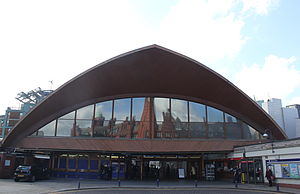
Back محطة قطار مانشستر أكسفورد رود Arabic محطة مانشستر اكسفورد رود ARZ Gorsaf reilffordd Oxford Road Manceinion Welsh Bahnhof Manchester Oxford Road German ایستگاه راهآهن خیابان آکسفورد منچستر Persian Gare de Manchester Oxford Road French Stazione di Manchester Oxford Road Italian Station Manchester Oxford Road Dutch Manchester Oxford Road Polish Manchester Oxford Road railway station SIMPLE
 The Grade-II listed timber facade of the station | |||||
| General information | |||||
| Location | Manchester city centre, City of Manchester England | ||||
| Coordinates | 53°28′26″N 2°14′32″W / 53.4739°N 2.2422°W | ||||
| Grid reference | SJ840974 | ||||
| Managed by | Northern Trains | ||||
| Transit authority | Greater Manchester | ||||
| Platforms | 5 | ||||
| Other information | |||||
| Station code | MCO | ||||
| Classification | DfT category C1 | ||||
| History | |||||
| Original company | Manchester, South Junction and Altrincham Railway | ||||
| Pre-grouping | Manchester, South Junction and Altrincham Railway | ||||
| Post-grouping | Manchester, South Junction and Altrincham Railway | ||||
| Key dates | |||||
| 20 July 1849 | Opened | ||||
| 12 September 1960 | Rebuilt and reopened | ||||
| Passengers | |||||
| 2018/19 | |||||
| 2019/20 | |||||
| Interchange | 0.998 million | ||||
| 2020/21 | |||||
| Interchange | | ||||
| 2021/22 | |||||
| Interchange | | ||||
| 2022/23 | |||||
| Interchange | | ||||
Listed Building – Grade II | |||||
| Feature | Manchester Oxford Road station (including platform structures) | ||||
| Designated | 24 November 1995 | ||||
| Reference no. | 1255053[1] | ||||
| |||||
| |||||
Manchester Oxford Road railway station is a railway station in Manchester, England, at the junction of Whitworth Street West and Oxford Street. It opened in 1849 and was rebuilt in 1960. It is the third busiest of the four stations in Manchester city centre.[2]
The station serves the southern part of Manchester city centre, the University of Manchester and Manchester Metropolitan University, on the line from Manchester Piccadilly westwards towards Warrington, Chester, Llandudno, Liverpool, Preston and Blackpool. Eastbound trains go beyond Piccadilly to Crewe, Leeds, Sheffield, Nottingham, Peterborough and Norwich. The station consists of four through platforms and one terminating bay platform.
The station sits on a Grade II listed viaduct, which was built in 1839 as part of the Manchester, South Junction and Altrincham Railway.[3] To reduce load on this viaduct, the station unusually utilises laminated wood structures as opposed to masonry, concrete, iron or steel. English Heritage describes it as a "building of outstanding architectural quality and technological interest; one of the most dramatic stations in England".[4] It was Grade II listed in 1995.[1] Architectural critic Nikolaus Pevsner described the station as "one of the most remarkable and unusual stations in the country".
It has long been envisaged, since the Manchester Hub plan in 2009, that the station will be upgraded and, in October 2016, a Transport and Works Act 1992 application was submitted to extend platforms at the station as part of the wider Manchester Piccadilly and Manchester Oxford Road Capacity Scheme.[5][6] As of 2019[update], this application remains active but has not been approved by government.[7] As a key transition node for both north–south and east–west transpennine routes, it is a recognised bottleneck and is the most delayed major station in the United Kingdom according to a Which? study in 2018 with over three quarters of services failing to depart on time during peak hours.[8][9] In an attempt to obligate the DfT to provide funding for the Oxford Road upgrade to improve punctuality, Network Rail declared the Castlefield Corridor 'congested' in September 2019.[10][11]
- ^ a b Historic England. "Manchester Oxford Road station (including platform structures) (1255053)". National Heritage List for England. Retrieved 3 November 2012.
- ^ "Office of Rail & Road Statistics 2022-23". Retrieved 23 April 2024.
- ^ Historic England. "Manchester South Junction and Altrincham Railway Viaduct (1200837)". National Heritage List for England. Retrieved 1 October 2018.
- ^ "Our plans: Manchester Oxford Road". Network Rail. Archived from the original on 22 November 2013. Retrieved 22 November 2013.
- ^ "Enhancements Delivery Plan". Network Rail. September 2016. p. 11. Archived from the original on 29 September 2012. Retrieved 8 January 2017.
- ^ "Watch: How Piccadilly and Oxford Road stations could look after £1bn redevelopment". Manchester Evening News. 8 October 2014. Retrieved 20 October 2018.
- ^ Cox, Charlotte (8 February 2017). "Piccadilly Station should get two new platforms - but does 'crass stupidity' mean it might never happen?". Manchester Evening News.
- ^ Paton, Graeme (16 October 2018). "Manchester Oxford Road station is worst for delays". The Times. London.
- ^ "UK's railway stations with most train delays revealed". BBC News. 16 October 2018.
- ^ "Castlefield Corridor - Congested Infrastructure Report: Capacity Analysis – System Operator" (PDF). Network Rail. 6 September 2019. Retrieved 2 December 2019.
- ^ "Twenty Fourth Supplemental Agreement to the Track Access Contract" (PDF). Office of Rail and Road. 1 July 2019. Retrieved 2 December 2019.
It noted that Network Rail had highlighted that the Corridor has congestion issues between 0700 and 2000 and would be more than happy to contractually agree to the additional rights being confined to the proposed hours of operation.
